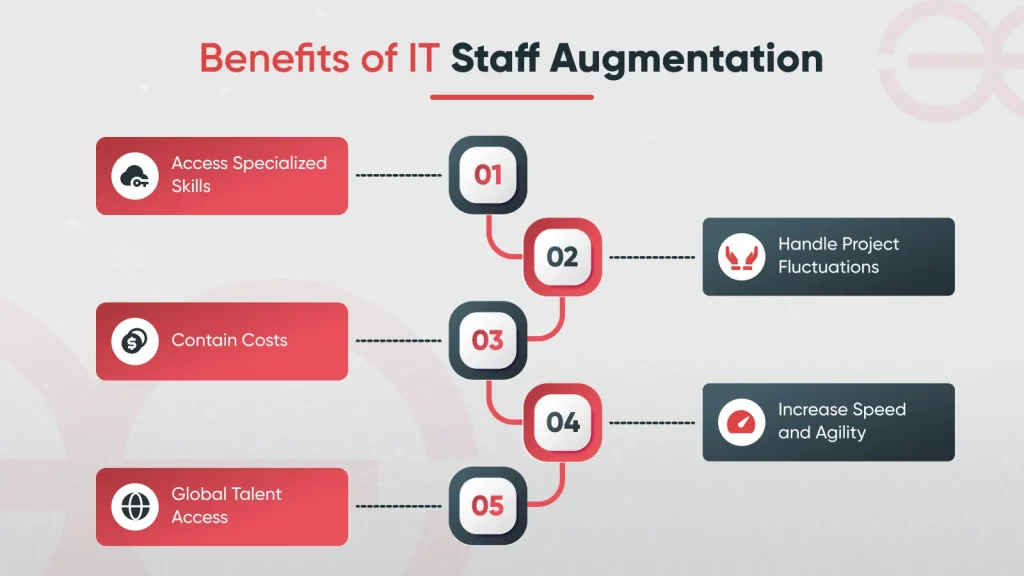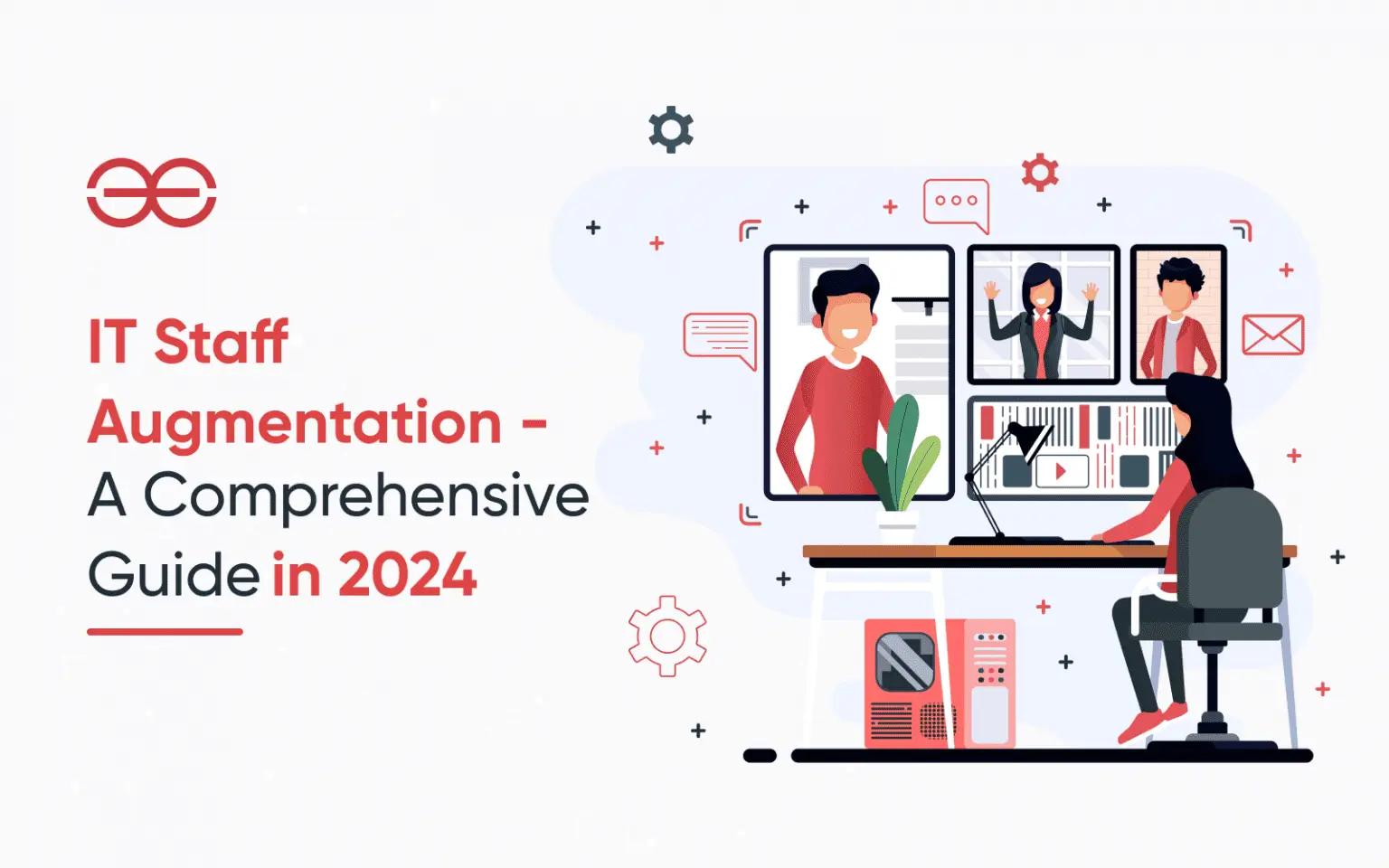With the rapid pace of technological advancement and digital transformation, businesses must ensure they have the right IT talent and skills – Of course to remain competitive and innovative. Though, finding qualified in-house IT professionals can be challenging and costly. This is where IT staffing augmentation comes in… it’s the practice of hiring temporary or contract-based IT personnel to fill knowledge, skills, or resource gaps.
Software development staff augmentation provides tremendous value in today’s dynamic business landscape. It gives companies fast and flexible access to niche technology expertise without the expense of permanent hiring. Companies can get support on-demand for projects that require specialized roles like app developers, data scientists, cybersecurity specialists, and more.
Before opting for on-staff augmentation, probably you likely want to learn more about how it works and the benefits it can provide. Pause here.. We’ve put together this comprehensive guide to help you understand the ins and outs of nearshore staff augmentation.
Table of Contents
ToggleFirst Thing First…
… What is Staff Augmentation?
IT staff augmentation involves contracting external tech troops on a temporary or project-specific basis. Such professionals supplement or expand the capabilities of a company’s in-house IT team. It allows companies to fill skill gaps, take on short-term projects, manage seasonal workload fluctuations, or access niche expertise without making permanent hires.
With IT staff augmentation, companies maintain control over their core IT staff while leveraging the flexibility of on-demand talent. Besides, external contractors work under the management of the internal team. Companies can easily augment IT skills like application development, QA testing, cybersecurity, data science, DevOps, and technical support.
It provides cost-efficiency, instant access to specialized talent, and the ability to scale teams up or down as needed. Better yet, the contract IT professionals brought in through staffing augmentation are highly skilled independent workers who can do wonders for you.
Benefits of IT Staff Augmentation

1. Access Specialized Skills
Augment your team with niche expertise like blockchain, AI, cybersecurity, and emerging technologies that your current staff may lack. Bring in contractors already equipped with the latest technical capabilities without investing time and resources into training permanent employees or recruiting specialized full-time staff.
2. Handle Project Fluctuations
You can easily scale your IT capacity up or down to match workload needs and project timelines. Moreover, the companies can prevent waste from idle permanent staff and resources during low activity periods. All you need to do is pay only for the specific roles and duration required to complete initiatives.
3. Contain Costs
Software development staff augmentation significantly reduces expenses compared to large permanent IT staff. By only paying contracted rates for the required skills, you can bring down the overall expenses of your company. Also, you can avoid extended recruiting and long-term training costs of full-time specialized hires.
4. Increase Speed and Agility
Rapidly deploying additional IT resources for time-sensitive initiatives without lengthy hiring processes – can save you from hassle. With staffing augmentation, you quickly scale your team with on-demand talent while easily adjusting skills and roles as your needs change.
5. Global Talent Access
Select contractors from a much larger global pool of qualified IT professionals across geographies compared to limiting yourself to local permanent hiring. Get greater diversity of knowledge and experience.
Strategies for Implementing Staff Augmentation
-
Identify Skill Gaps
Before choosing nearshore staff augmentation… you must perform a thorough assessment of your current IT team and the organizational technology strategy. Plus, determine competencies your staff lacks, key roles you need to fill, specialized technical abilities required for projects, and goals you aim to achieve through augmentation – like cybersecurity enhancement or application development bandwidth.
-
Build Staffing Plan
Develop a comprehensive staffing plan that highlights the roles, key responsibilities, duration of assignment, and costs for augmented staff hires. Estimate workload and needs across permanent and temporary staffing while defining governance processes.
-
Find Staffing Partners
Research and vet staffing agencies or IT consulting firms that can effectively source highly qualified global talent. In addition, assess their expertise in specialized skills, recruiting capabilities, training processes, and cultural fit. Select partners who will understand needs and provide top candidates.
-
Onboard and Integrate
Create a thorough onboarding process so augmented staff easily transition into roles. Ensure proper training, access to systems/tools, and integration support to work collaboratively with in-house teams. But all this… defines responsibilities clearly.
-
Manage and Optimize
For effective staffing augmentation, institute oversight models involving goal setting, status reviews, and feedback processes to manage augmented staff. Track key performance indicators and metrics.
Also, gather ongoing feedback to improve staffing approach while managing contract renewals, staff turnover, and redeployment based on evolving needs.
Hiring Model for IT Staff Augmentation
1. Choose Between Single-Supplier or Multi-Supplier Models:
- Single-supplier model: Streamline by hiring all contract workers through one primary staffing partner. This simplifies management and coordination for the business. However, it can limit the diversity of skills and talent if relying on one firm’s network.
Example: Partnering solely with Toptal to fill all IT contractor roles.
- Multi-supplier model: Diversify by using multiple staffing partners to access a wider range of qualified candidates globally. This allows you to find the best talent for each role. However, it requires more oversight to manage multiple suppliers.
Example: Using both Toptal and Crossover to source candidates for developer and QA roles.
2. Leverage High-Quality Staffing Partnerships:
- Here you can partner with reputable IT staffing and consulting firms that have proven success sourcing highly skilled technical talent. Look for partners with deep networks and expertise in the required roles.
Example: Leveraging EPAM for their strength in finding US-based cloud engineers.
- Ensure partners thoroughly understand your needs and can identify, screen, and provide pre-vetted candidates who are a strong match.
Example: Working with Geeks of Kolachi to source mobile app developers with specific mobile platform experience.
3. Establish Clear Roles, Responsibilities, Policies:
- Clearly define the scope of work, expected deliverables, timeline, and responsibilities for each augmented staff member to avoid any confusion.
Example: Outlining all requirements in a detailed Statement of Work for each contractor.
- Identify reporting structures and how augmented staff will collaborate with in-house staffers. Make policies for management, oversight, and reviews.
Example: Assigning an in-house project manager to provide direction and evaluate performance.
4. Onboard for Success:
- For staffing augmentation, have a thorough onboarding process to provide necessary training, documentation, system access, and resources to get contractors productive quickly.
Example: A 2-week intensive onboarding boot camp to ramp up new contractors.
- Assign mentors from the in-house team to help new contractors transition smoothly and understand processes.
Example: Pairing contractors with an internal peer buddy for guidance.
5. Optimizing Over Time:
- Continuously evaluate technical capabilities, company culture fit, and performance of augmented staff members.
Example: Instituting quarterly contractor reviews.
- If not a good match, be ready to rotate contractors out and have a replacement pipeline in place.
Example: Maintaining a bench of pre-approved contractors to swap in.
- Track ROI metrics and feedback to refine and improve staffing approach.
Example: Monitoring contractor ramp-up time and in-house satisfaction.
6. Maintaining Agility:
- Use shorter-term contracts, under a year, to maintain flexibility and the ability to adjust skills as business needs change.
Example: Bringing in contractors on 6-month agreements.
- Have a framework to seamlessly scale the number of contractors up or down.
Example: Staffing models that can add or remove 10-20% of contractor capacity on short notice.
Wrap Up!
Indeed, IT staff augmentation is becoming an indispensable strategy for organizations to achieve agility, innovation, and cost optimization. By leveraging on-demand technical contractors, companies can rapidly tap into cutting-edge capabilities and top global talent without permanent hiring overheads.
Through careful planning and management, an augmented IT workforce provides the perfect balance of control, flexibility, and access to niche skills needed to drive success. Better yet, with the right hiring models – staffing augmentation enables tech teams to swiftly respond to priorities, adopt new technologies, and manage costs.
In today’s hypercompetitive digital era, a blended workforce of internal and contracted IT experts is key to seizing opportunities and leading change – and there is no second thought about it. Companies that apply the best practices outlined in this guide can create an augmented IT staffing framework to future-proof their firm.
The time has come to use on-demand technical expertise and skill sets that can propel your company’s digital capabilities to the next level and beyond.
Happy Reading…!


